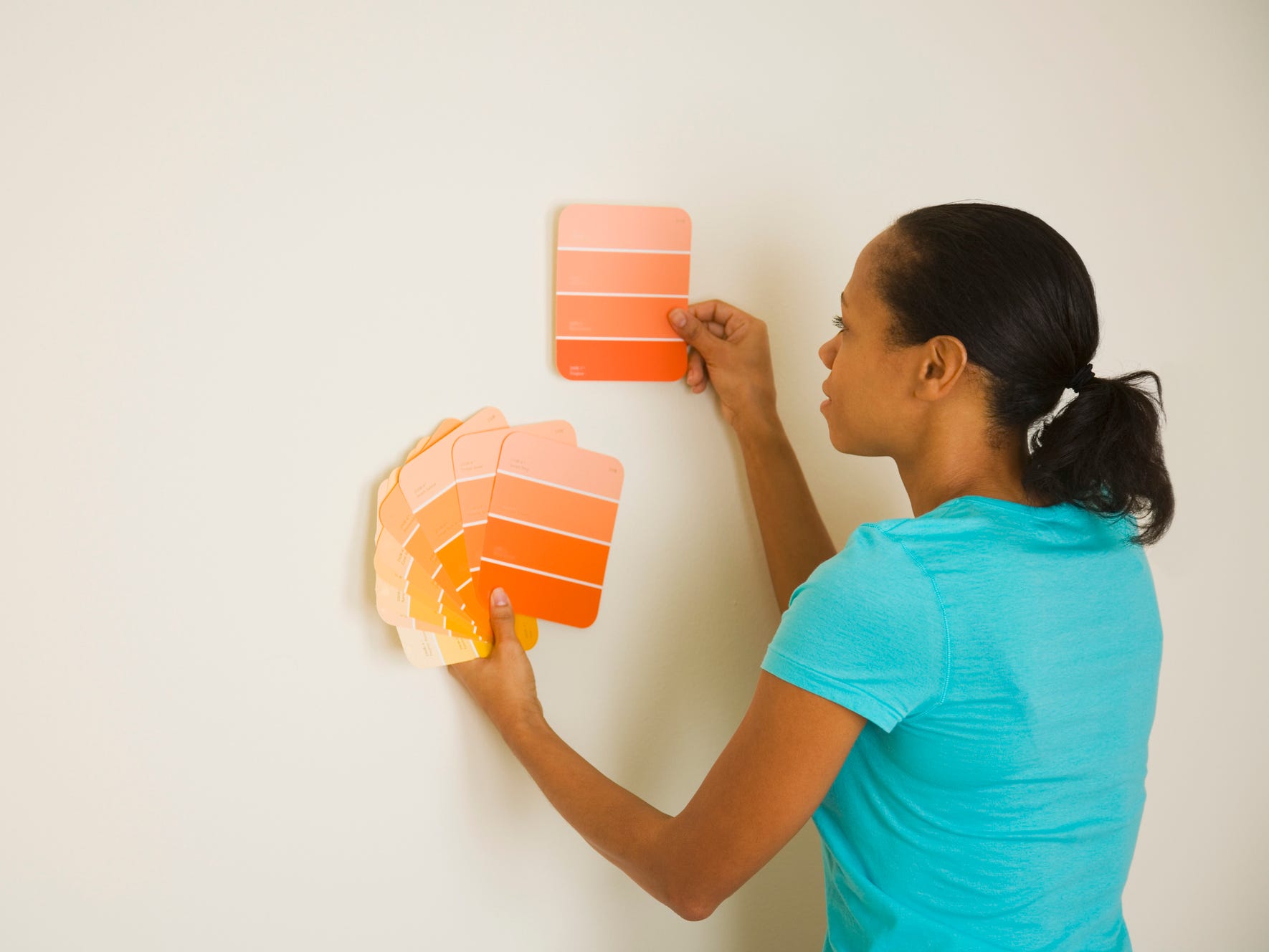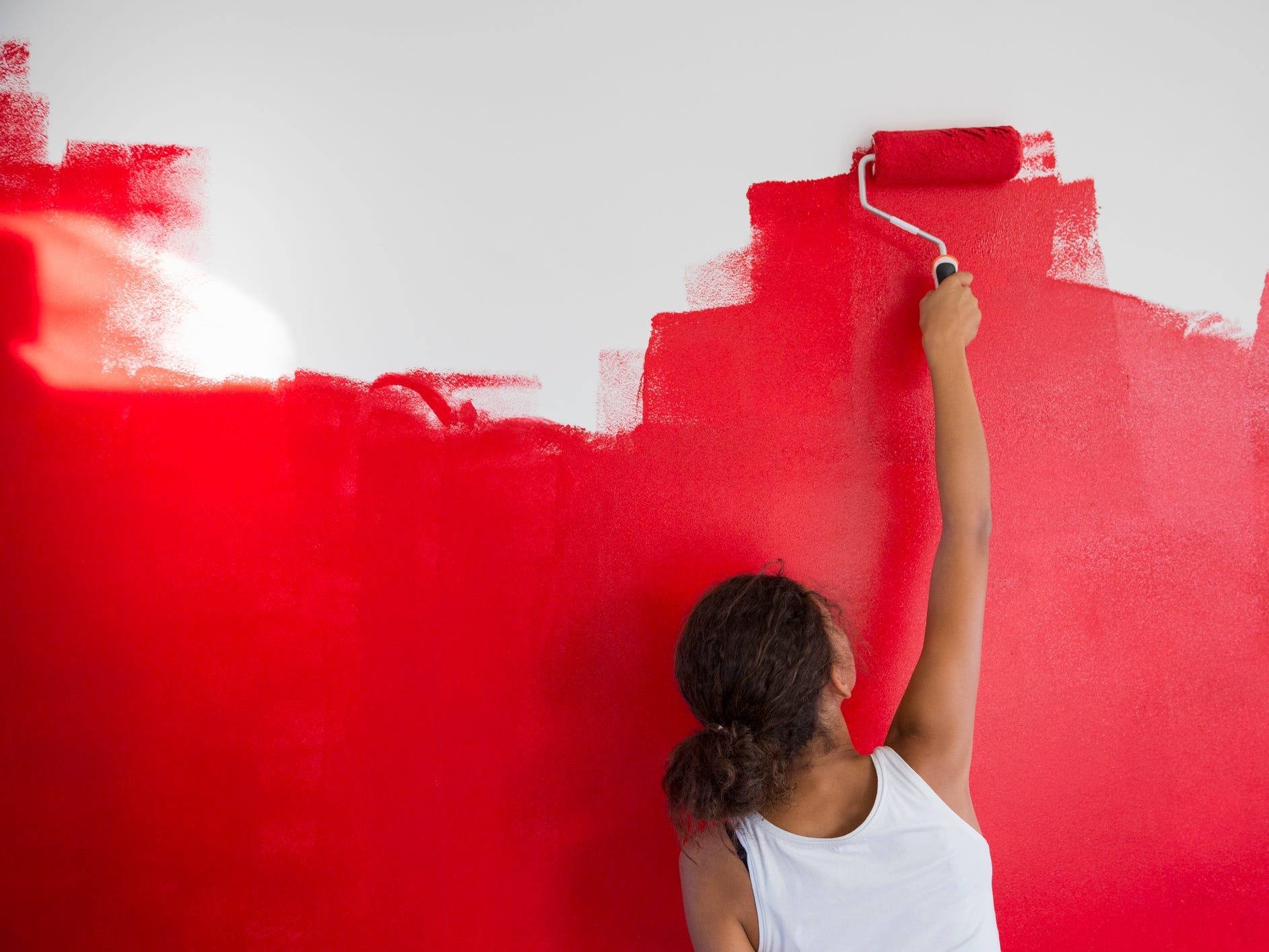
If you're a painting novice, tackling a DIY room painting project can be intimidating. But ensuring you have a plan in place, good tools at the ready, and a little bit of know-how – which is why you're here, after all – painting a room is an easy way into the world of DIY.
Follow these measured steps for room preparation and paint application, along with tips from professionals Doug Hershberger of Hershberger Painting in Sarasota, Florida and Clyde Miller of Level Up Painting in Rochester, New York. With a little thoughtfulness, you'll be able to achieve great results with minimal mishaps.
Planning your project

Terry Vine/Getty Images
There's a lot to think about before you even pick up a paintbrush. When planning your project, consider the current state of your room, existing materials and finishes, the dimensions of your room, and your goals for room transformation.
1. Choose your color. Color sets the mood for a room. Whether you're choosing a hue for an entire room or for an accent wall, Miller recommends starting with a paint chip, then purchasing and applying three different samples of paint side-by-side to the wall surface you intend to paint.
"You'll find there are 1,000 whites and 1,000 grays," he says. By applying a sample, you'll get the most accurate picture of how the color looks on the surfaces in your room with respect to lighting, sheen, and coverage. For walls, Miller recommends paint with an eggshell finish. "It's more washable than flat," he says.
2. Consider ceilings and trim. The majority of residential ceilings are flat, says Hershberger, for which he recommends an ultra-flat white paint. Go with the cheapest paint for ceilings. "It rarely gets touched," he explains. "You want it to be flat so that it doesn't show imperfections." For trim, he suggests using a higher quality paint, in a semi-gloss.
3. Determine your primer needs. A "primer" is generally known as a preparatory coat or an undercoat of paint used to serve as a binding layer between old or previously unpainted surfaces and new surfaces. Primer improves adhesion to porous surfaces such as drywall, blocks stains, and helps to create an even surface. For drywall ceilings, ceiling paint or flat paint can be used for primer.
Most walls and trim should be "primed" with a base coat of traditional primer. There are different types of primer for different surfaces, including drywall, wood, and plaster. Check with your local paint store professional for recommendations.
"The only time you shouldn't use a primer is when you know for sure what the previous paint is, and the color won't take more than one coat to cover," says Hershberger.
Beware of products that use this term to market an all-in-one paint and primer product. "On the market, there's no such thing as all-in-one primer," says Hershberger. Because surfaces and previous treatments are so variable, it's important to use the type of primer that is best suited to the specific job.
4. Know your wall type. "A lot of homeowners would help themselves by not putting water-based paint on oil," he says. Doing so can lead to peeling, he explains.
If your walls or trim were previously painted with oil-based paint, as is common with a lot of older homes, it's important to sand down the paint and apply a bonding primer. "This literally locks in the existing coat and gives a surface for the new coat," says Hershberger.
4. Calculate how much paint you need. Variables such as the texture and color of the wall you're painting over, the new color you have chosen, and primer will influence the amount of paint you'll need.
To calculate the base amount of paint you'll need for each coat, first, read the label on the container of paint you are purchasing to determine the specific product coverage. Most interior paints cover 250 to 350 square feet per gallon, says Hershberger. Next, multiply the dimensions of the room you are going to paint (wall height by width) to calculate the area. Finally, divide the total square footage by your chosen product's estimated paint coverage. Or just use an online paint calculator.
5. Gather tools and materials. Typically you'll need a collection of brushes and rollers, drop cloths, paint trays, and more. A full list of recommended materials is below.
Prepping the room

Kotenko_A/Getty Images
Now that everything's planned out and you've got all your supplies, the next step is to prepare the room. To facilitate a more efficient, mishap-free clean-up, Miller recommends designating a dropcloth area to store your paints and supplies.
1. Remove all the furniture you can. Move any remaining furniture, like large pieces you can't remove, to the middle of the room. Cover any remaining furniture and fixtures like ceiling fans with plastic.
2. Lay down drop cloths. Drop cloths are available in paper, plastic, burlap, and canvas materials. For floors, use canvas or cloth designed to catch heavy drips. Drop cloths with a plastic undercover should be placed plastic side down.
3. Remove obstacles and hardware. This includes light fixture covers, artwork, switch plates, and drapery.
4. Scrape any anomalies from ceiling and wall surfaces. Use a putty knife or five in one tool for this step.
5. Fill holes with putty (spackling/filling compound). Wait three to four hours for the putty to dry, then sand it down to a flat surface.
6. Tape (or "mask") over anything you don't want to paint. If you can, get a masking tool that helps you to apply tape in a steady, straight line, suggests Hershberger.
To mask without a tool, hold the tape in your dominant hand and pull the end with your non-dominant hand, stretching it an arm's length. With your thumb or finger, pin the end of the tape to the surface you want to mask. Pin the opposite end, and then the middle. Next, starting at the middle point, press the tape down evenly in opposite directions until smooth. This will prevent the tape from wrinkling. Mask in no longer than 18-inch increments, with as few tears as possible.
Painting the walls

Easy Production/Getty Images
Follow these steps for a finished product you'll be proud of. If you're priming, go through the steps twice, once with primer, and once again with paint.
1. Pour paint into trays or buckets. Pour ceiling and wall paint a quarter of a gallon at a time to allow for even distribution of paint on your roller or brush.
2. Paint ceilings first. Using an angle sash brush, paint all the areas in the field where the wall meets the ceiling. Then, use a roller to paint the remaining ceiling.
3. Paint trim and baseboards next. Pour 1 inch of paint into a clean, small bucket for this step and use an angle brush.
4. Cut in. First, paint (or "cut in") areas that are too tight to be reached by a roller. With an angle sash brush, paint edges with a straight steady motion. Push your brush into the bottom of the paint can to "load" it, then scrape brush on the rim of the paint can to remove excess paint.
Keep a wet edge while painting, meaning don't let paint dry fully before you start the next step. "Everything you roll should be wet when you roll over the top," says Hershberger.
5. Roll out. Dip your roller in the paint until it's saturated, and scrape off to remove excess. Transfer paint to the wall, then "lay out" the paint in a steady sweeping motion.
When you're rolling paint, think about the application as being made of two components: Transferring paint from the paint tray to the wall. And laying it out. "Get the paint on the wall. Once it is there, lay it out (spread it) with even pressure with the roller," says Hershberger.
6. Apply additional coats. You can do this while the walls are slightly wet to the touch. In general, latex paints will be dry to the touch in one to two hours, while oil-based paints will be dry to the touch in six to eight hours.
Cleaning up

Miljan Živković/Getty Images
Take time to clean your newly painted room and allow it to dry properly, and you'll enjoy a polished finished product.
1. Remove tape and drop cloths. Painter's tape should be removed once the paint is dry to the touch. Gently score the paint at the edge of the tape with a razor blade to ensure you don't pull any paint up with the tape, then slowly pull off at a 45-degree angle.
2. Wash rollers and brushes until the water runs clear.
3. Store paint. Close paint cans with a rubber mallet to ensure they're properly sealed, and then stash them somewhere the climate won't fluctuate too much. A basement is ideal for storing leftover paint for touch-ups, says Miller.
4. Let the finished room dry for 24 to 48 hours before rehanging artwork, replacing drapery and fixtures and resetting furniture.
Insider's takeaway
While anyone can paint a room, when it comes to minimizing mistakes and making the most of your time and money, adopting an efficient, uniform plan can make a big difference. Invest in quality paint and an angle sash brush, use a steady brush and roller technique, and allow 24 to 48 hours for drying for best results.
